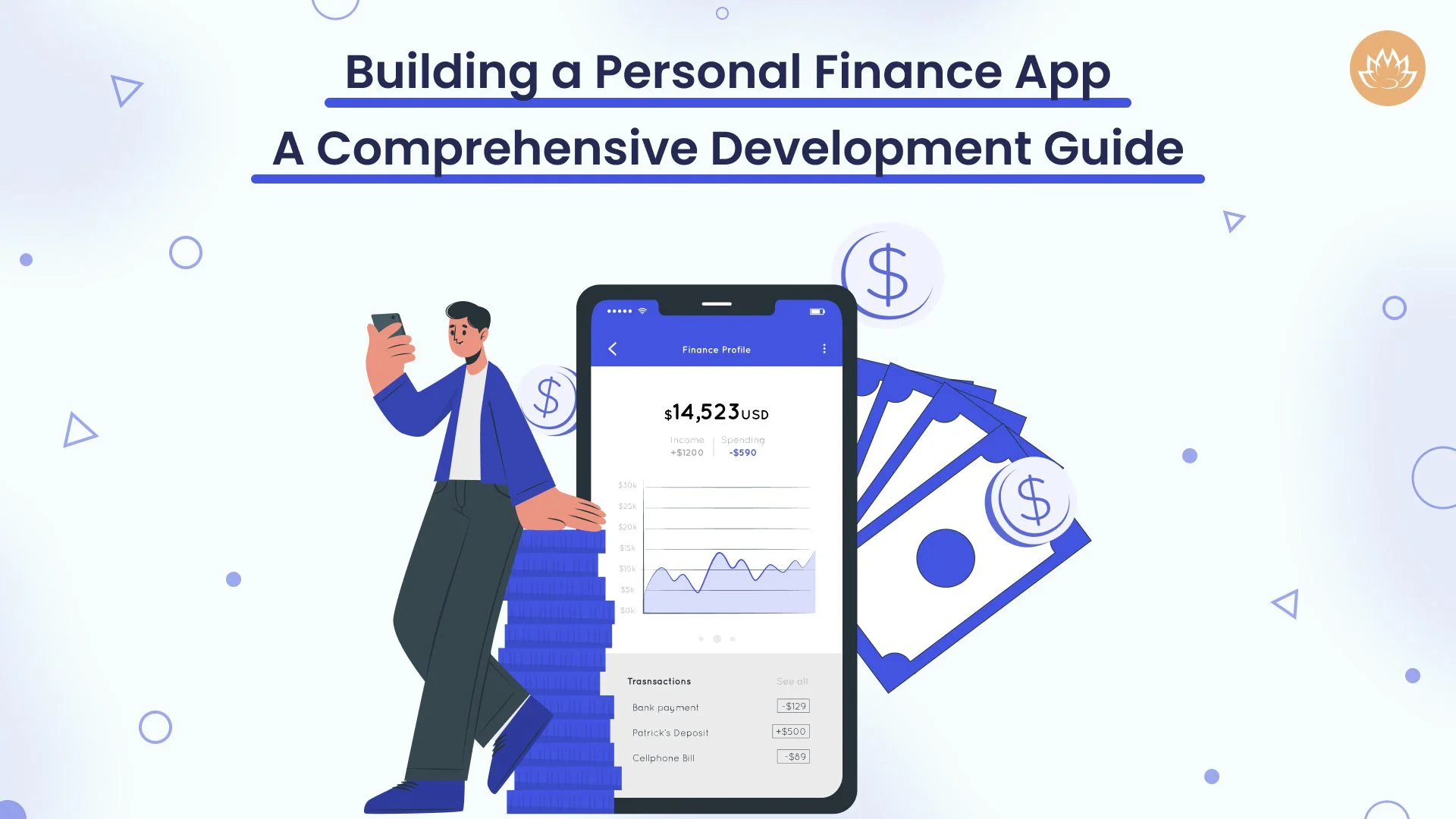It is very difficult for people to manage personal funds. However, technological advancement has made it easier than ever before. Would you like to build a personal finance app? Here is an all-inclusive development manual on how you can develop such an application, which would facilitate proper management of money by the users.
Modernly, individuals rely heavily on various technologies to make life easier. This also applies in relation to issues concerning money. Individuals can now monitor their expenditures, budget their earnings, and make financial objectives by pressing a few icons on their scrеens using modern technologies such as smartphones and mobile applications while being at risk. Developing a personal finance app is not only a viable money-making project, but it also serves as a helpful guide to people who are determined to keep their money affairs in order.
Creating an individual budget application involves careful strategy, designing well, and proper implementation. This complete manual will take you through the process of creating a user-centric, swift and rich-in-functionality application for personal finance. Such applications may work as a tool for entrepreneurs with ambitions to become business operators, as well as developers who seek to broaden their competencies. This guide will provide you with crucial information and helpful advice on how to convert your app idea towards making it a reality in practice. Therefore, we shall explore the realm of personal finance mobile applications towards creating a tool that helps users conquer their financial destiny.
Personal Finance Apps: An Overview
People must manage their money well if they want to have a financially viable life and fulfil their financial plans. This calls for the use of these personal finance apps. The process entails keeping tabs on earnings, expenditures, budgeting, savings, and investment. Failing to manage one’s finances paves the way for excessive debt, overspending, and zero savings.
Nowadays, personal finance apps have become convenient for consumers to monitor and handle their financial situations. Such apps include expense trackers, budgeting facilities, goal-setters, bill reminders, investment analysis, and financial reports. In general, a personal finance mobile app gives an individual more power over their money, allows for informed choices to be made that impact one’s financial prosperity, and, in general, leads to better finances.
Research and Planning
a. Identifying target audience and their needs:
It is important to find out what financial aspects will be addressed by the personal finance app prior to development. Such information may be sought after in market research, surveys, or interviews with users. The audience might consist of people of various ages, socio-economic classes, and saving objectives, among others.
b. Competitor analysis:
Analyzing existing personal finance apps on the market can give useful information about their characteristics, how they work, and their competitive stance. They also assist in analyzing various gaps that provide opportunities for differentiation.
c. Defining app features and functionalities:
The desired features and functionalities for the app will be identified based on the target audience’s needs and competitor analysis. This may incorporate expenditure monitoring, setting goals, sending bill reminders, following up on investments, as well as financial education materials, among many others.
Design and User Interface
a. Creating a user-friendly interface:
Thus, personal finance apps ought to feature a simple but user-friendly interface to allow easy navigation and comprehension by users. The interface will be aesthetically pleasing and have an organized structure of information.
b. Wireframing and prototyping:
As per a top mobile app development company in India, it is advisable that before embarking on the development part, one should come up with wireframes and prototypes for the app’s pages and user flow. This enables one to see how their app is structured in terms of its layout and interactions and hence gives them earlier feedback and iterative adjustments.
c. Incorporating intuitive navigation:
Thus, the app’s navigation must be clear and straightforward for users in terms of easily accessing various options and sections. Clear labels, icons, and visual cues can help users navigate through the app without confusion.
Development and Testing
a. Choosing the right technology stack:
In this regard, the technology stack will be dependent on considerations like the app’s levels of sophistication, scalable expectations, and available skill sets within the development team. Currently, the most popular technologies used to develop a mobile application are native platforms (iOS and Android) as well as cross-platform frameworks such as React Native or Flutter.
b. Backend development:
Server-side components are crucial in most cases of personal financial applications as they are needed to synchronize data, authenticate users, and integrate with other services such as the Internet. The selection of appropriate back-end technology and architecture is vital for the performance, security, and scaling of the app.
c. Testing and bug fixing:
Testing in detail should be done for the application, as it needs to be functional, stable, and secure. These tests include unit testing, integration testing, and user acceptance testing. Users should have a seamless running session; hence, bugs and errors identified during the testing process should be fixed immediately.
Security and Data Privacy
a. Implementing robust security measures:
This data is of a private nature and covers financial details associated with individuals. Strong encryptions and secure authentication technologies, such as data encryption at rest and in transit, are necessary tools for protecting user’s privacy and preventing any unauthorized access.
b. Complying with data privacy regulations:
Since 2018, personal finance apps must follow the European Union’s General Data Protection Regulation and CCPA in California. Allowing users to understand what is being done with their data, as well as granting consent and having transparent privacy policies, are part of this.
Launch and Marketing
a. App store optimization (ASO):
It is possible to better the app’s appearance on search results from the app store by optimizing its name, description, keywords, and screenshots. The firm ought to use ASO tactics that help improve its organic downloads.
b. Marketing and user acquisition:
It’s important to design a robust marketing plan if an entrepreneur intends to market the app and get users. Such examples may include ads in online stores, content marketing, partnership with influencers, social media campaigns, as well as app store ads.
c. User feedback and iteration:
User feedback collections and app analytics should be carried out in order to detect users’ satisfaction and identify points of improvement for future updates and iteration.
Ongoing Maintenance and Updates
a. Monitoring app performance and user feedback:
Continuously track the app’s progress, including factors such as app crash rates, download speed, and user involvement. Collect customer feedback to identify what needs to be improved and fix problems fast.
b. Addressing bug fixes and security vulnerabilities:
Quickly address any reported bug as well as security problems in order to make sure that the app is reliable. Updating your app regularly, including security patches and upgrades.
c. Continuously improving and adding new features:
In order to remain competitive, always keep adding new features and enhancements to the app. Assessing user sentiments, current market trends, and new technologies to spot chances for innovation and deliver better user interactions.
Final Thoughts
As such, designing a personal finance app will entail cautious preparations and taking some matters into cognizance. Overall, this comprehensive development guide has been very helpful by providing a guide on how one can create an effective as well as usable app. The process of developing an app involves conducting market research and identifying the target audience, developing a user-friendly interface, and putting in place sufficient security features. This guide should help developers develop a personal finance app that caters to user needs and offers useful features and capabilities in order to assist people in better managing their finances. Today, many consumers are using personal finance apps. Thus, any mobile application development company that invests in creating a great app will succeed in this competitive field.
Author

Kirtan is CEO of Whitelotus Corporation, an emerging tech agency aimed to empower startups and enterprises around the world by its digital software solutions such as mobile and web applications. As a CEO, he plays key role in business development by bringing innovation through latest technical service offering, creating various strategic partnerships, and help build company's global reputation by delivering excellence to customers.
View all posts









